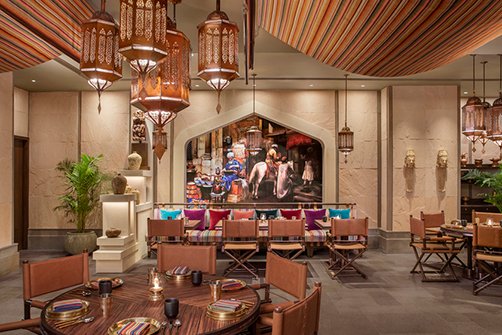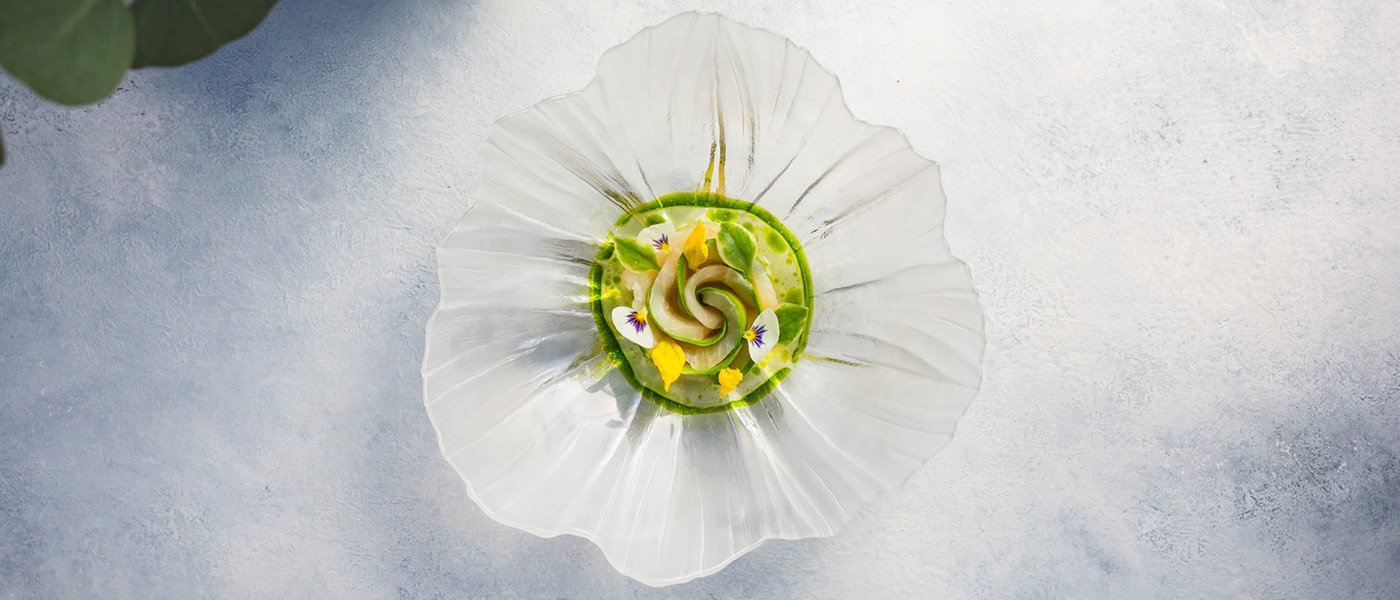I PRESSED THE DOORBELL of the whitewashed three-story townhouse, and waited. There was light chatter and the shuffling of footsteps inside. Through the window, I saw an interior bathed in warm lighting, and decorated with flickering candles and framed prints on wooden shelves, and swirls of potted botanicals on the windowsills. For a moment I thought I was heading to a lagom Swedish house party, but when the door opened, a smiling girl dressed smartly in a navy blue uniform said, “Welcome to Zén!”
Zén’s interior.
With a tasting menu that goes for S$450 per person, 24-seater Zén is the Lion City’s notorious Nordic newcomer. Its audacious price tag mirrors that of its Michelin three-starred sibling, Frantzén, in Stockholm, and restaurants of similar pedigree in northern and western Europe. Throw in drinks, which come in three pairing options—and the non-alcoholic set alone runs S$125—and you could be looking at a meal leaving you almost a grand lighter after taxes. Per person. The sum surpasses even Singapore’s Michelin winners such as Odette and Waku Ghin, and internationally acclaimed stalwarts such as three-star Nihonryori RyuGin in Tokyo and Amber in Hong Kong.
But if you’re Bjorn Frantzén, who owns a string of popular dining establishments in Stockholm (Michelin Plate Bobergs Matsal, wine bar Gaston, The Flying Elk) and Hong Kong (The Flying Elk), such derring-do may be unsurprising—especially when you’re backed by one of Singapore’s best spotters of culinary talent and trends, Loh Lik Peng, whose Unlisted Collection spans Michelin-starred Nouri and Burnt Ends, and the previous occupant of Zén’s address, two-starred Restaurant André.
Zén was making waves before it opened. I asked the footballer-turned-chef Frantzén what the deal was. “It doesn’t matter if it’s five or 500 euros; it should be maximum value, from the environment to glassware, to the service staff and quality of the ingredients,” he said. “Ten euros for a burger can be either expensive or cheap. What we’re trying to do is make dining here value for money.” Which begs the question: what is value for S$450?
In many ways, the dining industry has gotten more democratic in the past generation, with so many people fancying themselves foodies that the term has lost most meaning. Once you pass a certain echelon, every chef is seasonal… artisanal… idiosyncratic. Restaurants need to be ever inventive to set themselves apart. A high price tag will do it—but to what extent can you justify with rare ingredients and rarified service a bill beyond reach of almost everyone? I was pretty excited to say the least when Loh invited me and a plus-one to find out.
TOPLINE NOTES ON ZEN: You’ll get up-close-and-personal with fresh ingredients cooked with passion; there’s a palpable sense of teamwork in which everyone from executive chef Tristin Farmer—who has run kitchens under the Gordon Ramsay and Jason Atherton umbrellas—to the service staff and even interns prep and explain your dishes tableside; and the atmosphere is refreshingly relaxed with playful bantering and a rock-and-roll playlist sprinkled with Swedish contemporary pop. (Find a mix on Spotify under “Björn Frantzén.”)
But, actually, these sorts of things are the new norm in many high-end restaurants.
So what else is adding up? The obvious place to start is the ingredients, which read like a list of who’s who in the produce world. Think top-ranking Japanese Amaou strawberries considered the sweetest and juiciest of their kind. The parmesan custard in Zén’s signature French toast is made using Parmigiano Reggiano Vacche Rosse, aged for 36 months and strictly regulated for quality, while the drizzles of Casanova balsamic vinegar are aged by one of the oldest Italian producers in Modena for 25 years over juniper wood to bring out intense floral notes.
In fact, aging and fermentation are integral to Zén’s vocabulary. Shizuoka crown melons are aged in-house for two weeks to intensify their sweetness, then glazed with Manzanilla aigre-doux (sweet and sour dry sherry). “It’s time consuming,” Farmer said. “Everything we do is about taking a product that we find to be very good, treating it with the utmost care, and serving it in a way that showcases its full potential.” Some of the fermentations began weeks before Zén opened. You know, these days, funky is the new fancy.
The restaurant’s signature French toast with truffle.
MY FRIEND AND I sipped champagne and ate canapés. I swooned over the crunchy celeriac-nutmeg-black truffle taco and the grilled asparagus tartlet with a subtle kick from French Brillat-Savarin cheese that was spiced in-house with cep mushrooms and cloves. Then we toured the open kitchen and were introduced to our night’s indulgences displayed in their full glory—a standard part of every Zén experience, and another thing that ups the value-add.
A kinmedai fish from Chiba glowered at us from its bed of ice. There were marron from Western Australia, and Sarawak pineapples. Purple shiso and ginger flowers from Japan sat pretty in a box alongside a small tin of Zén’s unique house-blend caviar, which warrants an admiring pause. It’s made from the top three percent of the largest Oscietra sturgeon eggs with the brightest golden shimmer, cured in a secret Zén recipe for six months instead of the usual three. One way the delicacy is served is mixed with red deer tartare and argan oil.
The eight-course tasting menu is taken in the pinewood and copper-ceiling dining room on the second floor. Mr. Big Eyes kinmedai was binchotan-grilled and served with creamy sea urchin and Koshihikari rice that had been cooked then fried, resulting in a fragrant smoky/umami combo. The moreishly divine butter- poached marron (which, according to Loh, is rarely served in Singapore restaurants as the crayfish has to be kept alive right to the point where it is about to be cooked) was glazed in fermented yuzukosho paste made of fresh yuzus, Peruvian Aji Amarillo chilies and salt before being aged in-house for 10 days.
Short spiked bafun uni with 20 year aged black mirin.
The fresh and intense flavors in each of these were so amazing that they almost threatened to overshadow Zén’s innovative French toast—which in my mind won by a narrow margin because of the generous heaping of truffles. It looked like an ordinary piece of bread with a dollop of cream, but it was actually a decadent sourdough bread that had been aged and stuffed with onions stewed in butter before being topped with a thick swirl of parmesan custard and thinly sliced truffles. My heart swelled for this dish, along with my stomach.
WE OPTED FOR the mixed alcohol-and-juices pairing—and were handsomely rewarded. The surprises were mind-blowing. The Gen Sapphire Yodan Jikomi sake by the Katsuyama family brewery is no longer in production. Zén’s general manager and beverage director Aaron Jacobson had bought 25 bottles, and at the time of this writing only two were left. We were apparently one of the last people ever to taste a sake whose rice solids were extracted by a centrifuge machine, an “almost never used and extremely expensive way of clarifying,” Jacobson told me. “This process gives a much cleaner flavor due to the fact that there is no pressing of the rice, which lends to volatile flavor profiles. It was also filtered using the fukuro shibori system, where sake is poured into filter bags and allowed to drip down.” The result? A very clear sweet drink with an intensely rich mouthfeel that I can still remember.
Marron, crispy Koshihikari rice, yuzu pepper, clarified butter emulsion & sansho leaf.
Then there was the 2015 Le Zaune à Dédée that was paired with the kinmedai. Produced by a brother-and-sister team whose family has been cultivating grapes since 1650, it was a quirky orange-colored biodynamic white that was a blend of 80 percent skin-macerated Gewurztraminer and 20 percent Savagnin, the latter being aged sous-voile (under a veil of flora yeast) for seven years in oak barrels. I wasn’t a fan at first, but the pairing was key. Drinking it in between mouthfuls of the kinmedai, I found the floral notes accentuated the sweetness of the fish and the light tannic structure from the Gewurztraminer complimented the fattiness.
The juices were no second fiddles either. Each is made with a centrifuge to extract all the solids and pulp, leaving a clear liquid. Playing up the earthiness and sweetness in the French toast was a purple-carrot juice mixed with maple syrup that had been smoked in-house for six hours over cherry wood and the whole mixture left to sit for up to a day.
Even the curtain-closing “petite fruits” (my pick of the bunch: chamomile-glazed strawberries filled with edible pinecones) demonstrated so much attention to detail that I slowed down to savor them. At nearly one in the morning, my husband texted, asking if I was alright. I wasn’t; I was traumatized trying to decide between a second cup of soothing organic peppermint tea, or—YOLO—another shot of that heady 30 percent ABV Swedish punsch that I was sure would cause rueful regrets the next morning.
Beer-poached crustacean, smetana and wild trout roe.
Yet, luckily enough, I woke with only lingering reminiscences of amazing food served sizzling tableside on beautifully handcrafted crockery, the most creative beverages I’ve ever had, and the out-of-this-world, once-in-a-lifetime sake, all bolstered by easy-going and knowledgeable staff that I would gladly spend a year’s shopping budget (or the cost of a vacation in the region, for that matter) to hang out with all over again. And if another food-crazy and rock-and-roll-loving friend with deep pockets can come along, all the better.
restaurantzen.com; tasting menu at S$450 per person with drinks pairings at S$250 for alcohol, S$175 for mixed and S$125 for non-alcoholic.

